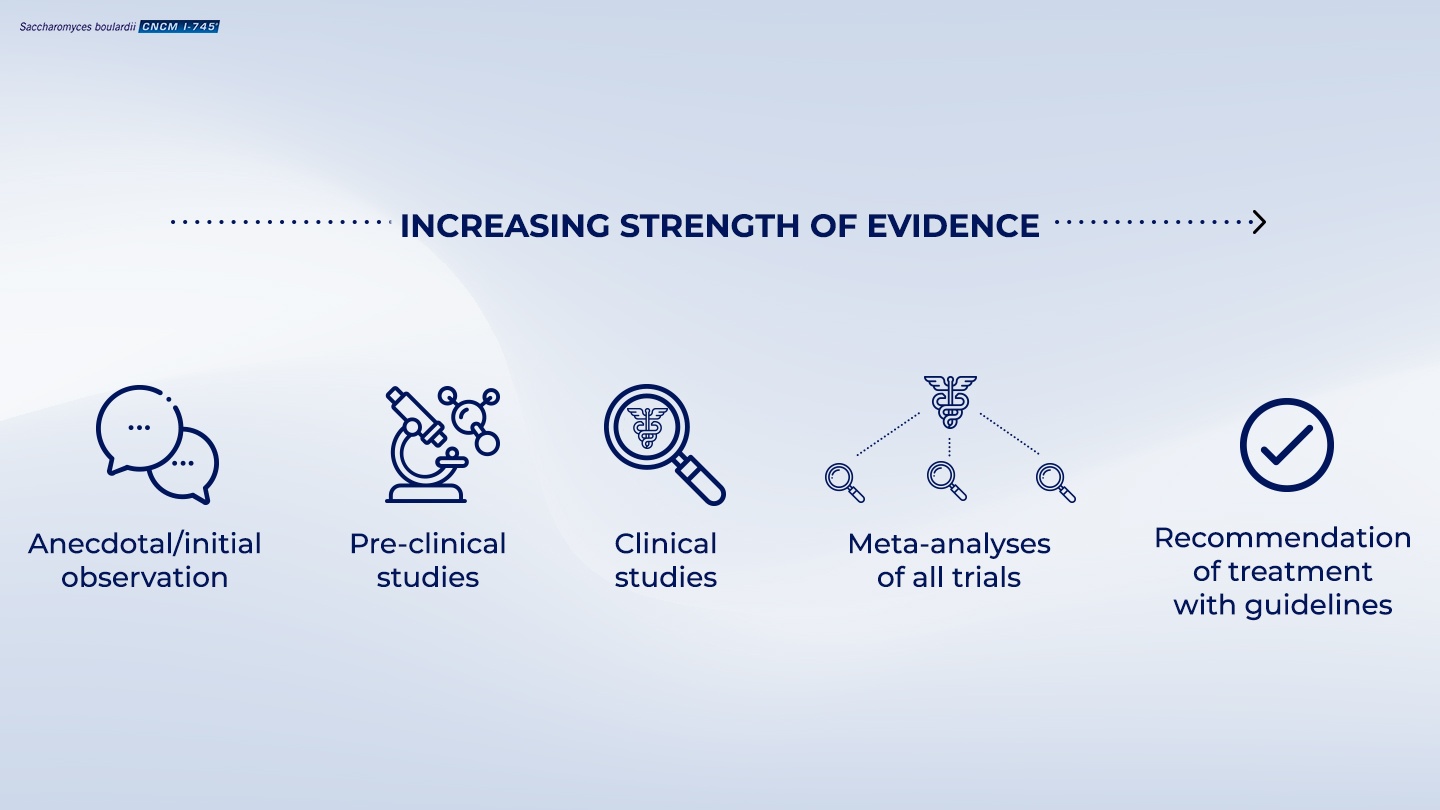What is the scientific evidence that demonstrates the health benefits of the probiotic Saccharomyces boulardii CNCM I-745?
- Video
- 5 min
What does scientific evidence mean when we talk about probiotics?
Some probiotic microorganism strains or products incorrectly use the term probiotic and make claims about health benefits that are not backed by scientific evidence or support.1
To be classified as a probiotic drug, it means there has been a clinically demonstrated beneficial effect and it has undergone strict evaluations1 in well-managed and good quality studies, as done for any drug.2 And, the name probiotic really should only apply to strains that have scientifically proven health benefits3.
For example, the yeast probiotic Saccharomyces boulardii CNCM I-745 is considered a probiotic drug.1 It was the first yeast probiotic identified and was the first probiotic used in human medicine1 and has been extensively studied.1
What do probiotic scientific studies demonstrate?
Scientific investigations, often referred to as pre-clinical studies, are studies that are performed in a laboratory using animal models or tissue or cell cultures.1 These studies are important to understand and demonstrate how a probiotic works and how it can offer a health benefit.4 This is called the “mechanism of action”.5
For Saccharomyces boulardii CNCM I-745, pre-clinical studies have demonstrated that it has specific proven mechanisms of action.5
For instance, these types of studies have demonstrated that the yeast has an anti-inflammatory effect by producing substances that influence both the person’s intestinal cells, as well as targeting pathogens.5
How is the beneficial effect of a probiotic investigated?
The health benefit(s) of a probiotic should be investigated in well-managed and designed clinical studies that compare two randomly allocated study groups of people – where one group receives the probiotic and the other receives a placebo or a different treatment.2 It depends on what the study is investigating as to which they use.2
An example of this kind of study that demonstrated the health benefits of Saccharomyces boulardii CNCM I-745 is where adult patients who were taking antibiotics were given a placebo probiotic treatment or S. boulardii CNCM I-745.1 However, none of the patients or investigators knew what the participants were taking. This is called a double blind study – because both groups and investigators don’t know who is receiving treatment. To determine how well the treatment worked, the investigators compared the incidence of diarrhea between the two groups. 1
In this way, they were able to show that only 9.5% of patients taking S. boulardii had antibiotic-associated diarrhea compared with 21.8% of patients taking placebo.1
What has been investigated in Saccharomyces boulardii CNCM I-745 clinical studies?
The health benefits of S. boulardii CNCM I-745 have also been demonstrated in studies investigating a variety of conditions associated with diarrhea,4 and have been demonstrated to have a very broad benefit compared with other probiotics.4
S. boulardii CNCM I-745 has strong evidence supporting its use* for:
- Management and prevention of acute diarrhea, including frequency of repeat episodes1
- Prevention of antibiotic-associated diarrhea1
- Prevention of recurrences of Clostridium difficile infections that can occur following antibiotic treatment1
*The prescribed usage of Saccharomyces boulardii CNCM I-745 for different conditions varies country to country. Please refer to your local Product Information or speak with your doctor.
Saccharomyces boulardii CNCM I-745 has strong data leading to strong recommendations
Saccharomyces boulardii CNCM I-745 has been also investigated in more than 100 clinical studies, generating strong data on its efficacy for treating, preventing and aiding recovery from diarrhea. It is this strong evidence that has led to it being included in main recommendations on the management of diarrhea in both children and adults, including the official guidelines of the World Gastroenterology Organisation (WGO)3, the European Society for Paediatric Gastroenterology, Hepatology, and Nutrition (ESPGHAN)6,7, Latin American expert group consensus (LATAM)8 and the Asia-Pacific recommendations for paediatric gastrointestinal disorders.9,10

References
- 01 . Joly, F et al. 2017. Saccharomyces boulardii CNCM I-745. Marteau, P and Dore J (Ed.), Gut Microbiota: A full-fledged organ. 2017: 305-326. Paris: John Libbey Eurotext.
- 02 . Shane A, et al. Guide to designing, conducting, publishing, and communicating results of clinical studies involving probiotic applications in human participants. Gut microbes. 2010 ; 1(4): 243-253.
- 03 . Guarner et al. Probiotics and prebiotics. World Gastroenterology Organisation Global Guidelines. February 2017. https://www.worldgastroenterology.org/guidelines/global-guidelines/probiotics-and-prebiotics/probiotics-and-prebiotics-english. Last accessed 11th December 2019.
- 04 . More MI, and Swidsinski, A. Saccharomyces boulardii CNCM I-745 supports regeneration of the intestinal microbiota after diarrheic dysbiosis–a review. Clinical and experimental gastroenterology. 2015; 8: 237.
- 05 . Czerucka D, and Rampal, P. Diversity of Saccharomyces boulardii CNCM I-745 mechanisms of action against intestinal infections. World journal of gastroenterology. 2019; 25(18): 2188.
- 06 . Szajewska H et al. Use of probiotics for management of acute gastroenteritis: a position paper by the ESPGHAN Working Group for Probiotics and Prebiotics. Journal of Pediatric Gastroenterology and Nutrition. 2014; 58(4): 531-9.
Alimentary pharmacology & therapeutics. 2015; 42(7): 793-801.
- 07 . Szajewska H, et al. Probiotics for the prevention of antibiotic-associated diarrhea in children. Journal of Pediatric Gastroenterology and Nutrition. 2016; 62(3): 495-506.
- 08 . Cruchet S, et al. The use of probiotics in pediatric gastroenterology: a review of the literature and recommendations by Latin-American experts. Pediatric Drugs. 2015; 17(3): 199-216.
- 09 . Cameron D, et al. Probiotics for gastrointestinal disorders: proposed recommendations for children of the Asia-Pacific region. World journal of gastroenterology. 2017; 23(45): 7952.
- 10 . Ghoshal UC, et al. The role of the microbiome and the use of probiotics in gastrointestinal disorders in adults in the Asia‐Pacific region‐background and recommendations of a regional consensus meeting. Journal of gastroenterology and Hepatology. 2018; 33(1): 57-69.
